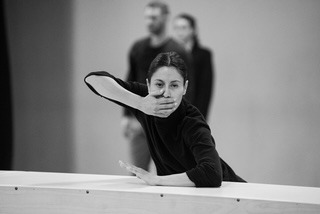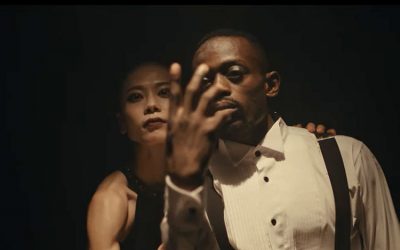Sunset Review: Simon Miraudo, The Guardian
In Our Town, Sunset and Boorna Waanginy, the city’s past is remembered, present celebrated and future forewarned
Waiting outside the abandoned men’s asylum, I’m about to be led hand-in-hand to Sunset hospital, where I’ll become one of its first new intakes in more than 20 years. I’m not going alone.
A few dozen other men and women are also stepping back in time for the world premiere of Perth Festival’s interactive theatre piece Sunset, which is inspired by the actual sanctuary-turned-heritage site that once housed forgotten men and became forgotten itself.
We’re all committed to being committed – so long as it’s just for an hour or so.
I’ll admit, I was suspicious of Sunset’s intentions. The creatives emphasised in their pre-show remarks that this would be merely the first artistic “activation” of the space – but it is a building whose history is tinged with tragedy and trauma, which now lies languishing in a suburb where the average house sells for $2.3m. The sad stories of the real and destitute men who once sought solace here would be told – or exploited – for our fleeting entertainment.
But Sunset turned out to be an exhilarating confrontation with memory, a yearning to face our tragedies and traumas head on – and performed with stunning skill. It is a communion with the dead and, as I’d learn from the opening weekend of Perth festival, reckoning with our ghosts, and our mucky history of wilful ignorance is a powerful process. By design, this year’s festival – the final year under the curation of the artistic director, Wendy Martin – is making us all go through that process together.
Sunset is directed and choreographed by Maxine Doyle, who helped conceive Sleep No More – the New York interactive and immersive sensation in which you walk through a hotel as Macbeth unfolds around you.
You don’t do much walking in Sunset; after being individually summoned by a nurse and natty maitre d’ you are instead directed to rickety chairs scattered in a mess hall, to watch the STRUT dance company bring to life sorrowful stories of the hospital’s ex-inhabitants. The auditorium isn’t air-conditioned and the dancers are sweaty; the creeping scent of body odour is a feature, not a bug, I swear.
Advertisement
The show, which moves you around the space for different experiences and angles, shares obvious influences with Sleep No More, such as Club Silencio from Mulholland Drive; the “dance of death” from The Seventh Seal; and the Overlook Hotel from The Shining – particularly as its characters’ memories flicker in and out of existence. Its 70 minutes passed too quickly.
The next night held the opposite of a stress-nightmare: Thornton Wilder’s quaint, Pulitzer Prize-winning Our Town, acted out by a troupe of novice locals. You might wonder what the play, penned in the 1930s and set in New Hampshire, has to offer today’s residents of WA. It’s the hiring of three First Nations actors in lead roles, and familiar everyday citizens in supporting – yet substantial – parts, which asks the people of Perth to see themselves and their past more clearly than lily-white adaptations ever could.
The sparse show is staged in the open air of the State Theatre Centre courtyard, in the round. Acts one and two are intentionally mundane, dominated by its endearingly unpolished stars, including some drama teachers, their schoolchildren, an Uber Eats driver and, most bravely, a theatre critic.
The third act, however, packs a wallop, as one of the three trained performers, Abbie-lee Lewis, wrestles with the afterlife and mourns the humdrum world she left behind and failed to appreciate while alive. She is heartbreaking; I’m glad they left this job to a pro.
As far as communal experiences go, little can top Boorna Waanginy: The Trees Speak, a $1m spectacle where Dreamtime stories are projected on to the towering flora of Kings Park at night, turning the hilltop environment into a breathtaking shadow play of a long-lost era.
On Friday and Saturday, its walkway was trekked by more than 115,000 people, surpassing the total number of visitors in 2017, when its premiere was marred by unseasonal rain.
This year, it’s met by a record-breaking heatwave. Even the elements are doing their part for this commentary on climate change.
On the journey, we heard how Indigenous people survived on Whadjuk land for 50,000 years without inflicting damage. I paused like many others at a section in which the lights were shut off one by one to mirror our impending extinction. The throng of visitors were seated, spellbound, on the grass – maybe because it was also a pretty good make-out spot as far as public community events go, but maybe also because the message was genuinely, finally resonating.
In Our Town, a planted audience participant asks, “Is there any culture or love of beauty in Grover’s Corners?” Many in Perth wonder the same of their own city. Like Grover’s Corners, Perth can seem small and panicked by encroaching weather. These arguments thin during summer, when culture swarms us and everyone temporarily stops threatening to move to Melbourne.
In 2015, 1 million people watched The Giants walk for Perth festival, reminding us how big our town was. Now, in 2019, we’re being asked to imagine what else we could be.
You can read the article on The Guardian here.



